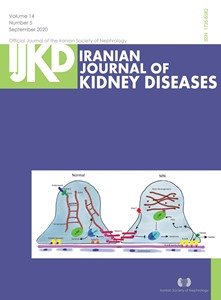The Survey of Relationship Between Resistance Index of Renal Artery and Albuminuria in Diabetic Patients Referring to Shahid Sayyad Shirazi Hospital, 2017 to 2018
Abstract
Introduction. The Resistance Index by doppler ultrasound has been characterized as a non-invasive diagnostic method that has been well predictive of the outcome of renal function in type 2 diabetic patients. This study aims to investigate the relationship between renal artery resistance index (RI) and albuminuria in diabetic patients. Methods. This descriptive, analytical, cross-sectional study was conducted on diabetic patients referred to the clinic for ultrasonography. Patients were divided into two groups: macro albuminuria and microalbuminuria or normoalbuminuria and for all patients, ultrasonography was done using the same ultrasound machine and by the same operator. Doppler sonography of the renal arteries was performed and the results were recorded. Results. 52.4% of the patients were female. The mean age of these patients was 50.25 ± 16.41. The mean RI in the study population was 66.0 ± 0.01. In this study, RI with albuminuria and HbA1c levels in diabetic patients were not significant. However, there was a significant relationship between RI and serum creatinine in diabetic patients, with increasing creatinine level, RI was also increased. Also, there was a significant relationship between RI and gender and this indicator had a direct relation with male gender but there was no correlation with female gender. Conclusion. In the current study, the patient’s albuminuria, type of treatment and HbA1c had no effect on the RI. The study also found that an increase in the RI index could be a significant predictor of renal dysfunction and increased creatinine.Downloads
Download data is not yet available.
Downloads
Published
2020-09-16
Issue
Section
ORIGINAL | Kidney Diseases
How to Cite
The Survey of Relationship Between Resistance Index of Renal Artery and Albuminuria in Diabetic Patients Referring to Shahid Sayyad Shirazi Hospital, 2017 to 2018. (2020). Iranian Journal of Kidney Diseases, 14(5), 358-364. https://ijkd.org/index.php/ijkd/article/view/4963


